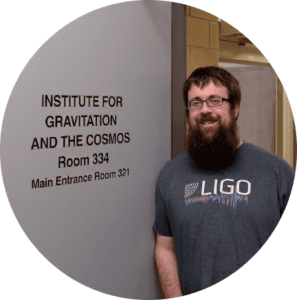Discovering gravitational waves

Cody Messick ’10 was part of the team that confirmed the existence of gravitational waves, which some believe is the greatest discovery in physics in 100 years.
Cody Messick ’10, currently a doctoral student at Penn State University, was part of a team of scientists who confirmed the existence of gravitational waves – ripples in the fabric of space-time that resulted from the collision of massive black holes more than 1 billion years ago. He was the featured speaker during a small summertime event showcasing Clark College’s outstanding alumni, programs, students and faculty.
The intimate gathering at the estate of Ed and Dollie Lynch in Vancouver, Wash., brought together 35 friends of Clark College and Clark College Foundation with an interest in the college and its programs. They were treated to a special night of cosmic findings as Messick talked about the identification of gravitational waves, why the discovery is important to science and what it means for the future of humankind.
Until 2015, the ripples or waves were only theoretical based on Albert Einstein’s General Theory of Relativity. But teams of scientists from across the globe have collaborated for decades to make a breakthrough discovery, using two giant observatories that are thousands of miles apart. The facilities are called the Laser Interferometer Gravitational-Wave Observatory (LIGO) and are located in Hanford, Wash., and Livingston, La..
Messick, Clark College’s 2017 Rising Star Alumni awardee, said that since the initial finding in September 2015, two more instances of gravitational waves have been confirmed.

Read more about Cody’s work in a Partners magazine story.
Clark Professor Dick Shamrell, who has since retired, was instrumental in getting Messick interested in physics. Messick said he did poorly in high school and didn’t have an interest in science until he took courses at Clark. It was Shamrell’s class specifically that ignited his passion for physics and launched his journey. The alumnus is currently in his fifth year at Penn State University studying astrophysics. Following post-doctoral work, he intends to follow in the footsteps of Shamrell by becoming a physics professor who will inspire students to explore and study the sciences.
Video by Simulating eXtreme Spacetimes (SXS) Project



